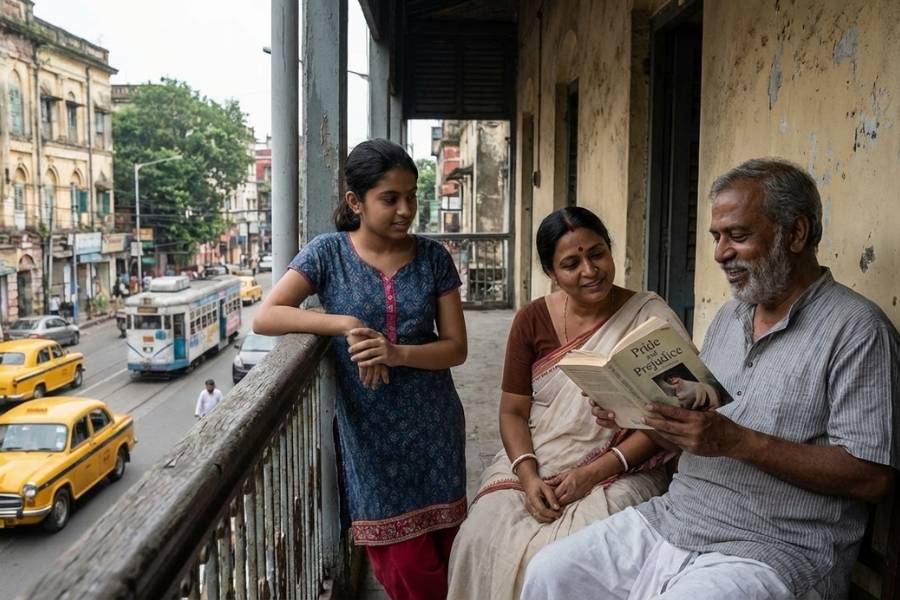 |
 |
| ROYAL TEACHER: Queen Victoria ( top) and a portrait of Abdul Karim (below) by Rudolph Swoboda. The Queen also commissioned Joachim Von Angeli to paint a portrait of Karim |
To the Royal Household, the Queen’s attitude to Abdul Karim began to gradually remind them of her relationship with John Brown, her Highland servant… After Prince Albert’s death, when the Queen was inconsolable, it fell to John Brown to bring her out of seclusion. At forty-two, the Queen had chosen to wear black all her life and had withdrawn into a shell. Brown was a commonplace, coarse man with a typical Highland sense of humour. He loved his whisky and was often rude to the Prince of Wales and the Household, who disliked the influence he had on the Queen.
***
Beneath the regal trappings, the Queen was very much a people’s person. She enjoyed nothing more than getting to know her subjects, specially the country folk and the underprivileged. At Balmoral, she regularly went to the village shops and chatted with the locals, often buying knick-knacks… In the quiet setting of the Highlands, the Queen became closer to Karim. He described the hunting in India and the journeys he had made to Kabul and the North-West with his father. The Queen was impressed by his candour and felt relaxed in his company, much to the discomfiture of the Household. They did not approve of the closeness that seemed to be developing between the Queen and the young Indian servant...
Karim was not aware of the Household’s early wariness of him. He remained close to the Queen and asked her many questions of his own. She told him about her family, her grandchildren and the relations in Europe. The Queen reminisced about Albert and the happy times they had spent in Balmoral. Karim saw the statues of John Brown that the Queen had erected in Balmoral and learnt about the Highland servant who had been so close to her. In the slight chill of the September days, Karim and the Queen got to know each other better. In less than two months he had mastered reading Queen Victoria’s handwriting, which at most times defeated even the patient Ponsonby (Henry Ponsonby, private secretary to Queen Victoria.) The Queen started writing to him directly instead of giving instructions through her Household.
The Queen now gave Karim the room previously occupied by John Brown, the symbolic act being immediately noticed by the Household. ‘I am rather surprised that Abdul occupies John Brown’s room,’ Sir William Jenner, the Royal physician, wrote to Reid (John Reid, personal physician to the Queen), ‘I don’t believe in the ghosts of those long dead or I should expect one in that room.’
In November 1888 Abdul Karim prepared to go to India on leave. The Queen, already so dependent on him, entered in her journal on November 2: ‘Had my last Hindustani lesson, as good Abdul goes home to India tomorrow on leave, which I regret, as it will be very difficult to study alone, and he is very handy and useful in many ways.’
Karim had landed on British shores to be a khidmatgar and waiter. A year later, he was returning to India on annual leave as a Munshi, the Queen’s teacher and official Indian clerk. He was still only twenty-five.
***
The Queen wrote to Karim regularly while he was away and enquired about his family. Karim let her know that his father, Wuzeeruddin, was due to retire soon and the family could face some financial hardships. He said his father was hoping the British government would give him a pension. Karim also informed her that Dr John Tyler, superintendent of the Agra Jail, wanted a promotion.
The Queen immediately wrote to the Viceroy, Lord Lansdowne, asking for a promotion for Tyler and a pension for Dr Mohammed Wuzeeruddin, the father of her ‘dear Munshi’. The Viceroy replied that he thought it advisable ‘not to take steps’ on the matter immediately upon his arrival, but suggested that he would do so when he visited Agra and ascertained the facts about both Tyler and Wuzeeruddin.
His answer did not satisfy the Queen. The Viceroy would soon learn that Queen Victoria could be very persistent when she needed something…
***
With the Queen backing him at every stage, the Munshi was growing in self-importance. An incident at Sandringham House made the Royal Household realise just how demanding Abdul Karim was becoming. On 26 April 1889, the entire Royal entourage, including the Queen and the Prince and Princess of Wales, arrived at Sandringham for a gala performance. The Ball Room had been converted into a theatre for the staging of The Bells by Emile Erckmann and Alexandre Chatrian. It was a melodrama translated from the original French Le Juif Polonais (The Polish Jew). The Queen described the piece as ‘very thrilling’ and thoroughly enjoyed the performance…
But there was one member of the audience who was not pleased. It was the Munshi. He found that he had been seated with the servants. Taking it as a deep personal insult, the Munshi stalked out and spent the rest of the evening sulking in his room. The next morning he told the Queen about it. Immediately she declared that Abdul Karim should always be seated with the Royal Household. The Munshi had climbed his first step on the social ladder.
The following year, at the Braemar Games, the Munshi was seen fraternising with the gentry. When an amazed Duke of Connaught (Prince Arthur, Queen Victoria’s son) saw the Munshi’s turban bobbing among the top hats in the pavilion, he sent for Henry Ponsonby and asked him how the Munshi had come to be seated with the gentlemen. An equally exasperated Ponsonby replied that Abdul stood where he was ‘by the Queen’s order’...
***
The Queen was enjoying the Highland break at Balmoral with Abdul. The Household watched in shock and horror as she breezily left with Karim for Glassalt Shiel, a remote place three hours ride from Balmoral accessed only by a narrow road running along the lake. The house was the only one for miles around. Known as the Widow’s Cottage, it was the first house built by Victoria after the death of Albert. She had celebrated the housewarming with John Brown in 1868, dancing some animated reels and drinking a toast with ‘whisky-toddy’ on the occasion. It was to this isolated getaway — tucked away among the pine trees on the banks of Loch Muick — that she used to retire with John Brown, fuelling Court gossip. After Brown’s death she had sworn she would not return there.
As she took Karim to Glassalt Shiel, Reid wrote to Jenner: “The Queen is off today to Glassalt Shiel to stay there till tomorrow. She has not done this since 1882, having given it up when Brown died, and said she would never sleep there again. However, she has changed her mind and has taken Abdul with her.” There were no doubts in the Household anymore. Abdul Karim had replaced John Brown, and no one was pleased.











